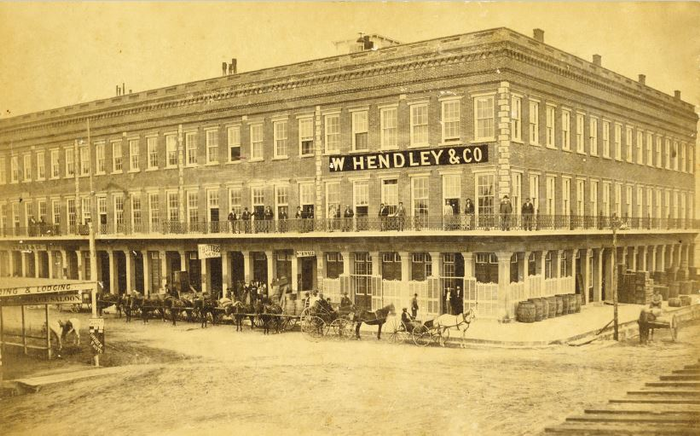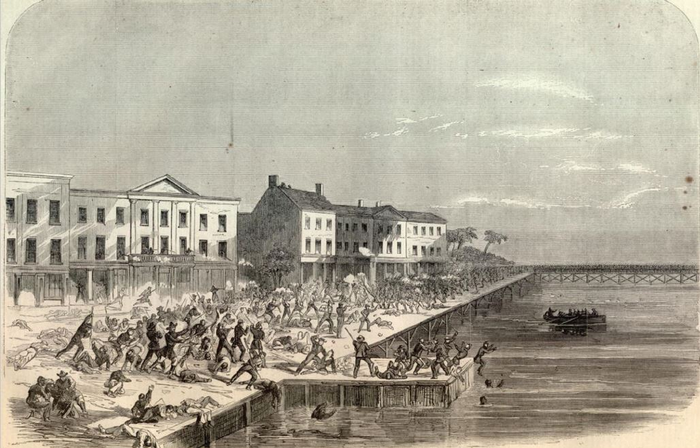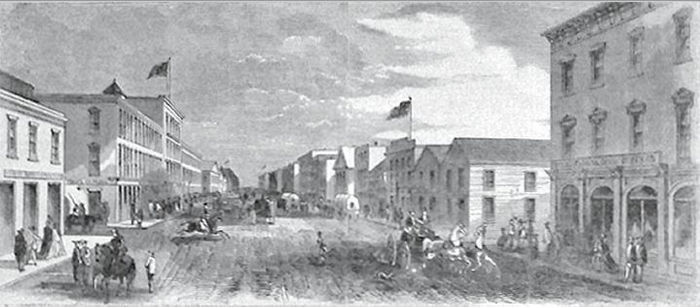After twenty years of working to prove its viability as a port of
commerce, Galveston
finally had railroad access to the interior. But the celebration of this triumph
was almost immediately thwarted by talk of war. The United
States was nigh a century old, yet it was already on
trial at the court of its ultimate destiny, and the exuberant outlook upon Galveston’s future
justifiably acquiesced to fear and worry as the fragile threads of the young
nation began to unravel.
At first the residents and businessmen of Galveston
were mostly complacent about the onset of civil war in the United States.
“The Island paused scarcely at all in the
conduct of its normal business [and] made only minimal defensive preparations.
(Kelly, p. 26)” Shippers and
merchants on the Strand balked at the idea that anything could dampen the
seemingly inevitable growth of Galveston, even after President Lincoln ordered
an embargo of all secessionist ports on April 19, 1861.
Soon, however, the stark reality of war reared its head. The
Confederacy’s predominant military strategy was defense, their priority being
to protect major territories. In Texas,
this meant that the burden of conflict was effectively transferred onto the
outlying and coastal communities. Galveston in
particular was deemed even more crucial because it was the closest major port
to Mexico,
an ally of the Confederacy.
On July 2, 1861, the peaceful clearance of federal ships into the Port of Galveston
ceased outright with the contested arrival of the naval vessel the South
Carolina. The island was officially a war zone,
and for the next five years Galveston’s sole purpose for existence would be the
defense of its precarious positioning, a plight that would forever alter the
entrepreneurial hierarchy of the Strand.
The first upset of Galveston’s
upper society came at the hands of an evacuating population that abandoned
their island homes to take refuge further inland. Soon after came the
casualties of war, as many prominent Galveston
citizens had taken up arms to defend the South. The ones who did survive their
military service chose to close their businesses until the end of the war.
Such
was the case with several members of the Trueheart family, tax assessors and
collectors who would eventually open the first real estate firm in Texas, located just off the Strand.
Many other businesses, such as the Galveston
Daily News, relocated temporarily to Houston.
Some businessmen, such as J.C. Kuhn, simply abandoned the island completely. In
1861 Kuhn sold three brick buildings on the Strand,
his wharf, and his home; he never returned.
 Many high-profile businessmen did remain in Galveston, but in staying true to the cause
they used their assets and connections in service of the Confederacy rather
than private commerce. William Pitt Ballinger, a lawyer with offices on the Strand, abandoned his practice to work as a Confederate
Receiver on the island, and still others used their commercial contacts and
resources to work as purchasing agents and blockade runners for the South’s
cause.
Many high-profile businessmen did remain in Galveston, but in staying true to the cause
they used their assets and connections in service of the Confederacy rather
than private commerce. William Pitt Ballinger, a lawyer with offices on the Strand, abandoned his practice to work as a Confederate
Receiver on the island, and still others used their commercial contacts and
resources to work as purchasing agents and blockade runners for the South’s
cause.
Ebenezer
B. Nichols purchased 2023 Strand (across from
Hendley Row) from Kuhn’s fire sale and relocated his commission house. During
the war The Nichols Building was used by the Confederate general Paul O. Hebert
as his headquarters, while Nichols himself went out and recruited over
eight-hundred men for the Confederacy.
Deprived of its commercial pursuits, the Strand
had become a battlefield. Hendley Row, the tallest building in the city at the
time, was repurposed as a military watch tower as it provided an excellent view
of the federal blockade. Then because of the building’s size and fortitude, it
was adopted as military headquarters, housing soldiers and also becoming the
pinnacle of perceived power. If a regiment wanted control of Galveston, they first had to control Hendley
Row.
Its position along the harbor also made it an easy target, however. The
alley and harbor shoreline had yet to be filled in, and at one time a Union gun
boat sailed right up to the north side of the building and blasted a cannon
ball through its thick brick walls. The scar from that blast remained on the
building for many years and was only recently repaired.
In late 1862 the island was seized by the Union with little fanfare, and
the Confederate forces that once occupied Galveston
vanished, seemingly as uninterested in returning as their commercial
counterparts.
Then, just after midnight on January 1st of 1963, in what is known as
the Battle of Galveston, Confederate troops under the leadership of General
“Prince” John MacGruder launched a surprise attack and reclaimed control of the
island. After that, the island remained in Confederate control until the end of
the war—it was one of only two Gulf coast ports left waving the rebel flag at
the conclusion of the Civil War.

In April of 1865, Generals Lee and Johnston surrendered their efforts to
the Union, and Galveston
officially surrendered a few months later on June 3. A month following, the federal blockade was at last rescinded and after four
years of meager shipments eking in through the maritime barrier, Galveston was
once again free to resume commerce.
The years of conflict on the Strand had
taken its toll and the merciless hands of war had nearly annihilated the city
with its destructive grip. Many of the wooden buildings in the commercial
district had burned or been badly damaged in the battles, as had the wharf.
Some buildings had been torn apart for firewood; homes and businesses were
looted bare—sometimes for supplies, sometimes for fun; Hendley Row had a gaping
hole in its side. Union troops now occupied the island, the price of redemption
known as Reconstruction.
 Nevertheless the city somehow managed to stay focused on resurrecting
its status as the commercial center of the southwest, even to the point of
graciously ignoring the presence of the federal military. Even residents who
found themselves on opposing sides just months ago managed to choose civility
and tolerance for the sake of Galveston’s
future. Anti-Union sympathies were considered uncouth and inappropriate to the
current cause. Galveston
could not save the Confederacy, but they could still save themselves.
Nevertheless the city somehow managed to stay focused on resurrecting
its status as the commercial center of the southwest, even to the point of
graciously ignoring the presence of the federal military. Even residents who
found themselves on opposing sides just months ago managed to choose civility
and tolerance for the sake of Galveston’s
future. Anti-Union sympathies were considered uncouth and inappropriate to the
current cause. Galveston
could not save the Confederacy, but they could still save themselves.
For the fiscal year that ended on August 31, 1866, Galveston’s port handled 375,000 tons of
cargo. The Strand slowly began to resemble
itself pre-war, lined predominantly with wooden buildings. The few brick
structures that survived the war were repaired, but among all of the returns to
its 1850s appearance, a new trend in architecture began to emerge that would
establish the Strand’s now-famous
aesthetic.
The Jockusch building, located on the southeast corner of 21st
and Strand, was built just after the war ended
and has a façade built of iron due to the lack of raw building materials at the
time. John Jockusch had been a resident of Galveston
since 1840 and served as the Prussian Consul to the Republic of Texas.
Twentieth century renovations of his building covered over the original brick
and iron with stucco, giving it a more modern appearance.
In 1866 the McMahan Bank was constructed on the southeast corner of 22nd Street.
A beautiful three-story brick building, it housed the enterprises of Thompson
H. McMahan who had been a prominent banker and merchant in Galveston since the 1850s. It was destroyed
by fire in 1877 and replaced by the First National Bank Building which still
stands today.
The
largest of all of the new structures was the P.J. Willis & Brothers
wholesale grocery house, cotton factory, and commission house. The massive
three-story structure built in 1869 took up the entire block of 24th Street north
of the Strand. P.J. and R.S. Willis were from Maryland and came to Galveston in 1837 where they secured a niche
within the realm of affordable food and clothing products. All that remains
today of their structure is the first floor which has been segmented into
several spaces occupied by the Mediterranean Chef, Crow’s Southwest Cantina,
and Brews Brothers.
In addition to new buildings, new faces arrived after the war as well.
Colonel W.L. Moody, whose name would reverberate through Galveston
for generations, saw not the destruction of Galveston but its potential for wealth and
opportunity.
As the decade drew to a close, the Strand
commercial district would bear the brunt of yet another foe, although this time
it was the forces of nature. Two major fires broke out on the street in 1869
that all but eliminated every wooden building west of 22nd Street. The Moro Castle
Saloon fire originated in one of the first buildings on the Strand, leveling it
and the entire southern block of the Strand
between 23rd and 24th Streets. This included the original
Merchants Mutual Insurance Company Building at 2317 Strand,
a replica of which was constructed in 1870 and still stands.
But as Galveston
had already proven once, and would prove again, it would take much more than
physical destruction to dampen its commercial endeavors. With the antiquated
wooden structures gone, the Strand was now
poised to become a symbol of the city’s outlandish prosperity, and to take its
place in the portals of history as an enduring architectural marvel.
Chapter 1 - 2 - 3 - 4 - 5 - 6 - 7- 8 - 9 - 10 -11 - 12